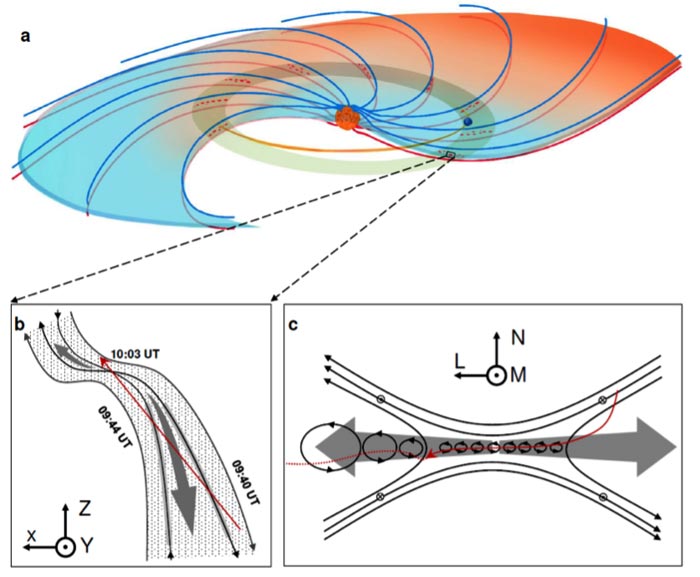Turbulent magnetic reconnection in solar wind

A schematic drawing of the heliospheric current sheet, a structure in the solar wind, and the reconnection paradigm within it
Credit: WANG Rongsheng et. al.
Researchers from the University of Science and Technology of China (USTC) of the Chinese Academy of Sciences, under the direction of Prof. WANG Rongsheng and Prof. LU Quanming, used data from the Magnetospheric Multiscale (MMS) mission to directly observe bursty and turbulent magnetic reconnection in the solar wind. Their findings were published in Nature Astronomy.
Magnetic reconnection is an energy-releasing process that causes explosive phenomena in interplanetary space. During the process, the magnetic energy is rapidly released to heat and accelerate the plasmas. Previous satellite observations of reconnection often display a bursty and turbulent state, such as flares on the surface of the sun, geomagnetic storms, and substorms in the planetary magnetospheres.
Sweeping from the sun and spreading over interplanetary space, the solar wind builds a bridge between solar bursts and magnetospheric turbulence. Unlike bursty and transient types in planetary magnetospheres, the previous viewpoint assumed magnetic reconnection in the solar wind displays a quasi-steady state, but there have been few direct detections of magnetic reconnection in the solar wind.
The research team utilized the high-resolution data of the MMS to detect the turbulent reconnection in the solar wind. The MMS is a four-spacecraft tetrahedron structure launched in 2015, aiming to unveil the secrets of the electron diffusion region of magnetic reconnection. Since October 2017, the MMS apogee has been raised to 25 Earth radii, making it possible to collect data in the interplanetary solar wind. For the first time, the research team found direct evidence of the turbulent reconnection in the solar wind. Moreover, the filamentary currents and flux ropes inside the diffusion region are observed, leading to a turbulent diffusion region. During the turbulent reconnection, the ions and electrons are effectively heated.
Based on the 76 magnetic reconnection events observed by the MMS, the researchers proved that bursty reconnection in the solar wind is more common than previously thought, and is responsible for solar wind acceleration and heating. They also found that the occurrence rate of reconnection increases with the speed of the solar wind.
This study reveals that turbulent magnetic reconnection can play an essential role in the energization of plasmas in the solar wind.
Journal: Nature Astronomy
DOI: 10.1038/s41550-022-01818-5
Article Title: Direct observation of turbulent magnetic reconnection in the solar wind
Article Publication Date: 10-Nov-2022
Media Contact
Jane Fan
University of Science and Technology of China
qfan@ustc.edu.cn
All latest news from the category: Physics and Astronomy
This area deals with the fundamental laws and building blocks of nature and how they interact, the properties and the behavior of matter, and research into space and time and their structures.
innovations-report provides in-depth reports and articles on subjects such as astrophysics, laser technologies, nuclear, quantum, particle and solid-state physics, nanotechnologies, planetary research and findings (Mars, Venus) and developments related to the Hubble Telescope.
Newest articles

A blueprint for mapping melting ice sheets
Researchers in the Stanford Radio Glaciology lab use radio waves to understand rapidly changing ice sheets and their contributions to global sea-level rise. This technique has revealed groundwater beneath Greenland,…

Water hyacinth plant pots – utilization of an invasive species
Together with Fiber Engineering GmbH, the DITF presents a process for the production of biodegradable plant pots. The products are cost effective and competitive. At the same time, the production…

Current research on the new 6G mobile communications standard
Nursing care robots, autonomous driving, digital twins: all of these high-tech applications will play an essential role for the new 6G mobile communications standard. The first commercial 6G networks are…



